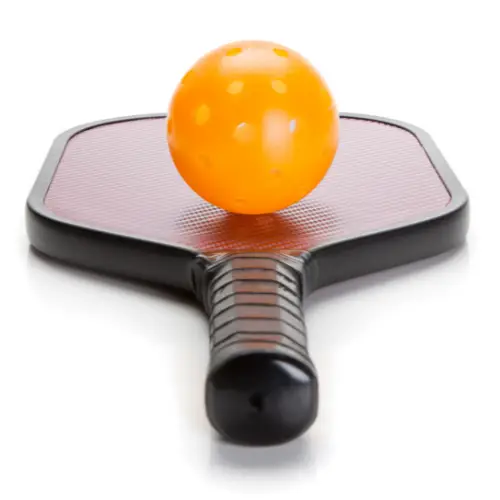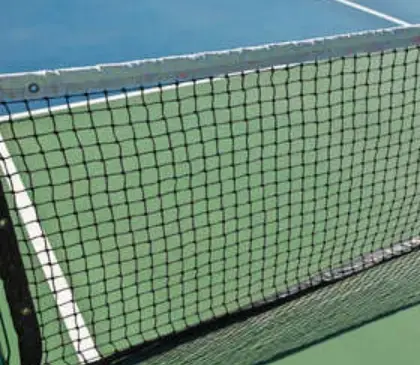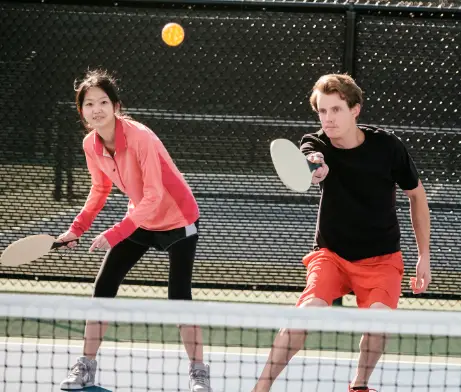Whether you’re just starting out in pickleball or you’re a seasoned pro, keeping the ball low can be a challenging but important skill to master. In this blog, we’ll go over some tips and strategies for keeping the ball low, including proper grip, arm positioning, and body mechanics. So if you want to improve your pickleball game and keep your opponents on their toes, keep reading!
Why Is It Important To Keep The Ball Low In Pickleball?
By keeping the ball low, you can lessen the likelihood that your opponent will take the initiative and rack up points in your favor. This is why it’s crucial for both competitive and recreational players to have this fundamental ability.
When you hit the ball excessively high, it’s known as an attackable ball, according to coaches and teammates alike. Such a ball will frequently be eliminated by your adversary with a forceful stroke or smash, or at the at least, put you and your team on the back foot.
A general rule in pickleball is that your opponent will have less attackable balls the lower you keep the ball on their side. By staying in the point longer, you increase your chances of winning the point. The possibility that your opponent will give you an attackable ball has increased as a result of you hitting the ball low and forcing them to hit high.
What Are The Techniques To Keep The Ball Low In Pickleball?
Pickleball players employ a wide variety of strategies to keep the ball low.
Here are some of the most important advice that, once learned, will help you keep the ball low. By doing these things, you can make it difficult for your adversaries to attack you while also raising the likelihood that you will receive an attackable ball in return.
- Avoid Hitting Low to High Shots Hard
In pickleball, you must strike the ball at a specific angle and with the appropriate touch if you want to keep the ball low.
It’s rather simple to perform what needs to be done when you make contact with the ball at net height or above.
It is necessary to keep the paddle face nearly parallel to the net (slightly slanted up to defy gravity) at contact to prevent the ball from passing low over the net, assuming you intend to send it back at higher speeds, which is typically what you would do on strokes that you contact high.
When you receive a low ball oneself and still need to make your shot clear the net, how do you keep the ball low on the opposite side? Well, you shoot softly from low to high.
- Target Your Opponent’s Feet
As previously said, it’s crucial to keep the ball low on your opponent’s side to prevent creating high-contact areas for them to hit down on and use to attack you.
One of the key goals of pickleball is to prevent attacks.
The truth is that as long as your opponent is unable to contact it high, it doesn’t matter whether it is high at any point on their side.
Therefore, making them “contact low” is the more crucial goal than than simply telling them to “keep it low.”
- Develop Quick Hands & Feet To Hit The Ball Early
You will be able to take the ball at the highest contact point available to you on that particular shot by moving to it as soon as it crosses the net and striking it at its greatest peak.
Maximizing this goal will be very helpful to you even though it’s not always achievable for a variety of reasons, such as when a shot needs to land in the kitchen because you can’t reach it out of the air.
In order to maximize the height of your contact with the ball, try to get to your shots as rapidly as you can.
- Contact (Comfortably) In Front & Paddle Face Angle
If you can hit the ball when it is directly in front of you rather than beside or behind you, you will be most effective. It’s just superior biomechanically. When your contact is out in front of your body, you can best direct your energy into the ball.
A “striking zone” is best created when you make contact with the ball up front since you can control your paddle and paddle face angle here.
- Be Conscious of Your Grip Pressure
How high or low you hit the ball can depend on how tightly you grasp the pickleball paddle.
Many individuals are unaware that it is simple to become sidetracked and unconsciously tighten your grip on your paddle’s handle when you are playing a hard and fast game, such as when you are in a hand speed fight at the net.
- Don’t Flick Your Wrist or Break Your Elbow
Excessive use of the wrist and/or elbow during your swing is one of the main causes of the ball accidentally going high.
We frequently witness this, so it’s crucial to minimize any wrist or elbow motion you may make while making contact.
- Learn Spin
Last but not least, adding spin to your game is one of the best things you can do to assist you keep the ball low. To keep the ball low, you can employ one of two forms of spin: topspin and underspin.
An exceptionally powerful tool in a pickleball player’s toolbox is topspin. It has the advantageous synergy of being both an attacking and a defensive shot at once.
Underspin is a different spin that, under the correct situations, can be employed to keep the ball low. Backspin and slicing are other terms for underspin.
What Are The Benefits Of Keeping The Ball Low?
There are several benefits to keeping the ball low in pickleball:
- It allows for better control: When you keep the ball low, it is easier to hit the ball consistently and with more control. This can help you place the ball exactly where you want it on the court, making it harder for your opponent to return it.
- It reduces the chances of making errors: High balls are often more difficult to hit accurately, as they require more power and precision. Keeping the ball low reduces the chances of making errors, as it allows you to make contact with the ball in a more controlled manner.
- It forces your opponent to move: When you keep the ball low, your opponent has to bend down to reach it, which can be tiring and disrupt their rhythm. This can also create openings for you to attack and put pressure on your opponent.
- It can disrupt your opponent’s strategy: If your opponent is used to hitting high balls, they may not be prepared for low balls, which can throw them off their game and disrupt their strategy.
- It can prevent your opponent from hitting powerful shots: Keeping the ball low can also prevent your opponent from hitting powerful shots, as they will have less time to react and generate power. This can help you neutralize your opponent’s strengths and keep them on the defensive.
Conclusion
In conclusion, keeping the ball low in pickleball is an important strategy for players to master in order to succeed in the game. It allows players to take control of the game by forcing their opponents to hit high, difficult shots and makes it more difficult for them to hit winners. It also allows players to keep the ball in play longer, increasing the chances of their opponents making mistakes. Overall, mastering the art of keeping the ball low is a crucial skill for any pickleball player looking to improve their game.







